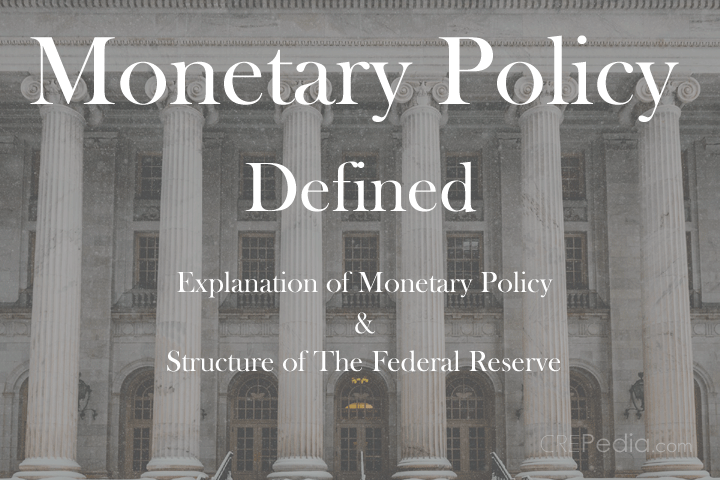What Is Monetary Policy?
Monetary policy is the system used by central banks to manage and maintain a sustainable economy through influencing the supply and cost of money in the financial system. This means monetary policy is executed by raising or lowering interest rates and managing the amount of money available to the financial system.

Who Administers Monetary Policy?
Monetary policy arose as governments recognized the need to ensure stable economies for their countries. Monetary policy is generally determined and carried out by central banks. As countries around the world encountered economic crises of their own, they adopted monetary policy as a means to help maintain stable economies.
Examples of central banks include the Federal Reserve in the United States, the Bank of Japan, or the Bank of England. Today's monetary policy can trace its origins back to the Bank of England which was established at the end of the 1600's.
Monetary Policy vs Fiscal Policy
Monetary policy differs from fiscal policy. Where monetary policy is carried out by central banks and affects the money supply and interests rates to guide the economy, fiscal policy consists of direct actions by government to either accelerate or decelerate the economy.
Fiscal policy is carried out by other parts of government and includes such methods as increasing or decreasing the tax rate, or decreasing or increasing government spending.
The Federal Reserve
In the United States, the need for monetary policy arose in response to the numerous economic down turns and crises the country experienced throughout its history. After periods with and without a central bank, the United States Congress created the Federal Reserve in 1913.
Structure And Role Of The Fed
The structure of the Fed was a comprise between centralized government control of the financial system, the private banking industry, and the regional needs of the economy. In addition to regulating and supervising the banking system to ensure the stability of the financial system, the Fed was also given the responsibility of ensuring macro economic stability through monetary policy.
The Federal Reserve System falls under the authority of the U.S. Congress. It is structured into three bodies:
- the Board Of Governors
- the regional Federal Reserve Banks
- the Federal Open Market Committee
The Board of Governors
The Board of Governors is a government entity made up of seven board members nominated by the President of the United States, and confirmed by the U.S. Senate. The Board of Governors overseas the banking system and helps establish policy.
The Twelve Federal Reserve Banks
There are twelve Federal Reserve Banks that serve twelve districts in the United States. Each Federal Reserve Bank is owned by member banks in its district. The Federal Reserve Banks support the operations of the banking system such as processing payments, printing money, conducting research and analysis, and holding auctions for Treasury Bills.
| 1 |
A |
Boston |
|
7 |
G |
Chicago |
| 2 |
B |
New York |
|
8 |
H |
St. Louis |
| 3 |
C |
Philadelphia |
|
9 |
I |
Minneapolis |
| 4 |
D |
Cleveland |
|
10 |
J |
Kansas City |
| 5 |
E |
Richmond |
|
11 |
K |
Dallas |
| 6 |
F |
Atlanta |
|
12 |
L |
San Francisco |
The Federal Open Market Committee
The Federal Open Market Committee is the primary body responsible for monetary policy in the United States. The voting members of the committee are The Board Of Governors, the president of the New York Federal Reserve Bank, and about a third of the presidents of the remaining district Federal Reserve banks in rotation. The committee sets the course of action of monetary policy through open market operations to keep the economy on course in alignment with its objectives and its dual mandate.
The Federal Reserve's Dual Mandate
In 1977 the United States Congress gave the Fed the "Dual Mandate." Under the mandate, the objectives of the Fed's Monetary Policy would be to 1) maximize employment, and 2) ensure price stability.
Tools Of Monetary Policy
In order to carry out monetary policy, the Fed has three primary tools it can use to influence the money supply and the inflation rate. The fed may engage in open market operations. This essentially means buying and selling government bonds.
The fed can also increase or decrease the reserve requirement of cash that banks must have on hand. By increasing the reserve requirement, banks must keep a larger portion of cash on hand. This reduces the amounts banks can lend and put into the economy.
Finally, the Fed can raise or lower the federal funds rate. This is the rate at which banks can borrow money from the federal reserve. The lower the rate, the more enticing it is for banks to borrow money which will in turn enter the financial system.
Monetary Policy And Commercial Real Estate Investment
A country's monetary policy has important consequences on commercial real estate investment. The most direct is the impact on interest rates. Since the interest rates on commercial mortgages have a significant impact on the feasibility and returns of buying investment properties, monetary policy can influence activity in the real estate investment market through raising and lowering interest rates.
Commercial real estate investments also occur in the context of the macro economic environment. Monetary policy's primary purpose is to ensure stability of the macro economic environment. This means monetary policy attempts to mitigate certain risks in the economy. Good monetary policy reduces economic risks and encourages good investments. Monetary policy is also meant to encourage employment. Employment is an important driver of demand for commercial space and commercial property.